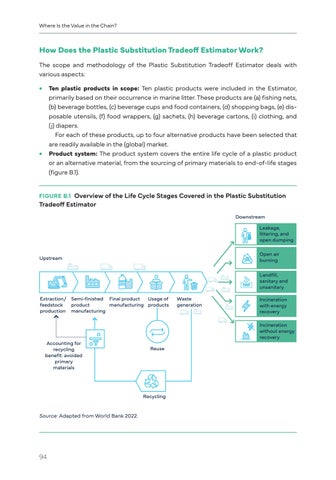Where Is the Value in the Chain?
How Does the Plastic Substitution Tradeoff Estimator Work? The scope and methodology of the Plastic Substitution Tradeoff Estimator deals with various aspects: ••Ten plastic products in scope: Ten plastic products were included in the Estimator, primarily based on their occurrence in marine litter. These products are (a) fishing nets, (b) beverage bottles, (c) beverage cups and food containers, (d) shopping bags, (e) disposable utensils, (f) food wrappers, (g) sachets, (h) beverage cartons, (i) clothing, and (j) diapers. For each of these products, up to four alternative products have been selected that are readily available in the (global) market. ••Product system: The product system covers the entire life cycle of a plastic product or an alternative material, from the sourcing of primary materials to end-of-life stages (figure B.1). FIGURE B.1 Overview of the Life Cycle Stages Covered in the Plastic Substitution
Tradeoff Estimator
Downstream Leakage, littering, and open dumping Open air burning
Upstream
Landfill, sanitary and unsanitary Extraction/ Semi-finished Final product Usage of feedstock product manufacturing products production manufacturing
Accounting for recycling benefit: avoided primary materials
94
Incineration with energy recovery Incineration without energy recovery
Reuse
Recycling
Source: Adapted from World Bank 2022.
Waste generation





